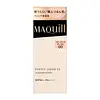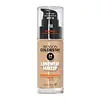Shiseido Maquillage Essence Liquid Ex Foundation SPF 50+ Versus Revlon Colorstay Makeup For Combination/Oily Skin SPF 15
What's inside
What's inside
 Key Ingredients
Key Ingredients

 Benefits
Benefits

 Concerns
Concerns

 Ingredients Side-by-side
Ingredients Side-by-side

Water
Skin ConditioningDipropylene Glycol
HumectantEthylhexyl Methoxycinnamate
UV AbsorberAlcohol Denat.
AntimicrobialGlycerin
HumectantEthylhexyl Salicylate
UV AbsorberPEG-8
HumectantPEG-60 Hydrogenated Castor Oil
EmulsifyingBis-Ethylhexyloxyphenol Methoxyphenyl Triazine
Skin ConditioningSilica
AbrasiveIsostearic Acid
CleansingPolyglyceryl-6 Polyricinoleate
EmulsifyingDiethylamino Hydroxybenzoyl Hexyl Benzoate
UV FilterAmmonium Acryloyldimethyltaurate/Beheneth-25 Methacrylate Crosspolymer
Emulsion StabilisingSodium Dilauramidoglutamide Lysine
HumectantPolyurethane-10
Glycylglycine
Tocopheryl Acetate
AntioxidantMagnesium Chloride
Sodium Acetylated Hyaluronate
HumectantIsodecyl Neopentanoate
EmollientSea Water Extract
Skin ConditioningSoluble Collagen
HumectantPEG-100 Hydrogenated Castor Oil
EmulsifyingSorbitan Sesquiisostearate
EmulsifyingAluminum Hydroxide
EmollientTrisodium EDTA
Acrylates/C10-30 Alkyl Acrylate Crosspolymer
Emulsion StabilisingDimethylacrylamide/Sodium Acryloyldimethyltaurate Crosspolymer
BHT
AntioxidantTocopherol
AntioxidantPotassium Hydroxide
BufferingSodium Metabisulfite
AntioxidantPEG-12 Dimethicone
Skin ConditioningButylene Glycol
HumectantC10-18 Triglycerides
EmollientCaprylic/Capric Triglyceride
MaskingTriethoxycaprylylsilane
Phenoxyethanol
PreservativeTitanium Dioxide
Cosmetic ColorantCI 77492
Cosmetic ColorantMica
Cosmetic ColorantWater, Dipropylene Glycol, Ethylhexyl Methoxycinnamate, Alcohol Denat., Glycerin, Ethylhexyl Salicylate, PEG-8, PEG-60 Hydrogenated Castor Oil, Bis-Ethylhexyloxyphenol Methoxyphenyl Triazine, Silica, Isostearic Acid, Polyglyceryl-6 Polyricinoleate, Diethylamino Hydroxybenzoyl Hexyl Benzoate, Ammonium Acryloyldimethyltaurate/Beheneth-25 Methacrylate Crosspolymer, Sodium Dilauramidoglutamide Lysine, Polyurethane-10, Glycylglycine, Tocopheryl Acetate, Magnesium Chloride, Sodium Acetylated Hyaluronate, Isodecyl Neopentanoate, Sea Water Extract, Soluble Collagen, PEG-100 Hydrogenated Castor Oil, Sorbitan Sesquiisostearate, Aluminum Hydroxide, Trisodium EDTA, Acrylates/C10-30 Alkyl Acrylate Crosspolymer, Dimethylacrylamide/Sodium Acryloyldimethyltaurate Crosspolymer, BHT, Tocopherol, Potassium Hydroxide, Sodium Metabisulfite, PEG-12 Dimethicone, Butylene Glycol, C10-18 Triglycerides, Caprylic/Capric Triglyceride, Triethoxycaprylylsilane, Phenoxyethanol, Titanium Dioxide, CI 77492, Mica
Titanium Dioxide
Cosmetic ColorantZinc Oxide
Cosmetic ColorantCyclopentasiloxane
EmollientWater
Skin ConditioningDimethicone
EmollientTrimethylsiloxysilicate
EmollientPEG-9 Polydimethylsiloxyethyl Dimethicone
EmulsifyingButylene Glycol
HumectantTribehenin
EmollientPhenyl Trimethicone
Skin ConditioningNylon-12
Cymbidium Grandiflorum Flower Extract
Skin ConditioningLactobacillus/Eriodictyon Californicum Ferment Extract
Skin ConditioningLilium Candidum Bulb Extract
Skin ConditioningMalva Sylvestris Extract
AstringentSodium Hyaluronate
HumectantTocopheryl Acetate
AntioxidantBisabolol
MaskingEthylhexyl Palmitate
EmollientTocopherol
AntioxidantAlcohol Denat.
AntimicrobialAlumina
AbrasiveDimethicone/PEG-10/15 Crosspolymer
Methicone
EmollientLaureth-7
EmulsifyingMagnesium Sulfate
Silica
AbrasivePolyglyceryl-3 Diisostearate
EmulsifyingEthylene Brassylate
MaskingTriethoxycaprylylsilane
Dimethicone/Silsesquioxane Copolymer
PEG-12 Glyceryl Dimyristate
Skin ConditioningSalicylic Acid
MaskingSilk Powder
Skin ConditioningSodium Citrate
BufferingDipropylene Glycol
HumectantSilica Dimethyl Silylate
EmollientSerica
HumectantTetrasodium EDTA
Hexylene Glycol
EmulsifyingCaprylyl Glycol
EmollientPhenoxyethanol
PreservativeEthylparaben
PreservativeMethylparaben
PreservativeMica
Cosmetic ColorantIron Oxides
CI 77891
Cosmetic ColorantTitanium Dioxide, Zinc Oxide, Cyclopentasiloxane, Water, Dimethicone, Trimethylsiloxysilicate, PEG-9 Polydimethylsiloxyethyl Dimethicone, Butylene Glycol, Tribehenin, Phenyl Trimethicone, Nylon-12, Cymbidium Grandiflorum Flower Extract, Lactobacillus/Eriodictyon Californicum Ferment Extract, Lilium Candidum Bulb Extract, Malva Sylvestris Extract, Sodium Hyaluronate, Tocopheryl Acetate, Bisabolol, Ethylhexyl Palmitate, Tocopherol, Alcohol Denat., Alumina, Dimethicone/PEG-10/15 Crosspolymer, Methicone, Laureth-7, Magnesium Sulfate, Silica, Polyglyceryl-3 Diisostearate, Ethylene Brassylate, Triethoxycaprylylsilane, Dimethicone/Silsesquioxane Copolymer, PEG-12 Glyceryl Dimyristate, Salicylic Acid, Silk Powder, Sodium Citrate, Dipropylene Glycol, Silica Dimethyl Silylate, Serica, Tetrasodium EDTA, Hexylene Glycol, Caprylyl Glycol, Phenoxyethanol, Ethylparaben, Methylparaben, Mica, Iron Oxides, CI 77891
Ingredients Explained
These ingredients are found in both products.
Ingredients higher up in an ingredient list are typically present in a larger amount.
Alcohol Denat. is an alcohol with a denaturant property. It is created by mixing ethanol with other additives.
This ingredient gets a bad rep because it is irritating and drying - mostly due to its astringent property. Astringents draw out natural oils in tissue, constricting pores and leaving your skin dried out.
However, alcohol denat. is not all that bad.
Due to its low molecular weight, alcohol denat. tends to evaporate quickly. One study on pig skin found half of applied alcohol evaporated in 10 seconds and less than 3% stayed on skin.
This also helps other ingredients become better absorbed upon application.
Studies are conflicted about whether this ingredient causes skin dehydration. One study from 2005 found adding emollients to propanol-based sanitizer decreased skin dryness and irritation. Another study found irritation only occurs if your skin is already damaged.
Small amounts of alcohol are generally tolerated by oily skin or people who live in humid environments.
The rule of thumb is if this alcohol is near the end of an ingredients list, it will probably not affect your skin much.
Also...
This ingredient has antimicrobial and solvent properties.
The antimicrobial property helps preserve products and increase their shelf life. As a solvent, it helps dissolve other ingredients.
Other types of astringent alcohols include:
Learn more about Alcohol Denat.Butylene Glycol (or BG) is used within cosmetic products for a few different reasons:
Overall, Butylene Glycol is a safe and well-rounded ingredient that works well with other ingredients.
Though this ingredient works well with most skin types, some people with sensitive skin may experience a reaction such as allergic rashes, closed comedones, or itchiness.
Learn more about Butylene GlycolDipropylene Glycol is a synthetically created humectant, stabilizer, and solvent.
This ingredient helps:
Dipropylene glycol is technically an alcohol, but it belongs to the glycol family (often considered part of the ‘good’ alcohols). This means it is hydrating and gentle on skin unlike drying solvent alcohols like denatured alcohol.
As a masking agent, Dipropylene Glycol can be used to cover the smell of other ingredients. However, it does not have a scent.
Studies show Dipropylene Glycol is considered safe to use in skincare.
Learn more about Dipropylene GlycolMica is a naturally occurring mineral used to add shimmer and color in cosmetics. It can also help improve the texture of a product or give it an opaque, white/silver color.
Serecite is the name for very fine but ragged grains of mica.
This ingredient is often coated with metal oxides like titanium dioxide. Trace amounts of heavy metals may be found in mica, but these metals are not harmful in our personal products.
Mica has been used since prehistoric times throughout the world. Ancient Egyptian, Indian, Greek, Roman, Aztec, and Chinese civilizations have used mica.
Learn more about MicaPhenoxyethanol is a preservative that has germicide, antimicrobial, and aromatic properties. Studies show that phenoxyethanol can prevent microbial growth. By itself, it has a scent that is similar to that of a rose.
It's often used in formulations along with Caprylyl Glycol to preserve the shelf life of products.
Silica, also known as silicon dioxide, is a naturally occurring mineral. It is used as a fine, spherical, and porous powder in cosmetics.
Though it has exfoliant properties, the function of silica varies depending on the product.
The unique structure of silica enhances the spreadability and adds smoothness, making it a great texture enhancer.
It is also used as an active carrier, emulsifier, and mattifier due to its ability to absorb excess oil.
In some products, tiny microneedles called spicules are made from silica or hydrolyzed sponge. When you rub them in, they lightly polish away dead skin layers and enhance the penetration of active ingredients.
Learn more about SilicaTitanium dioxide is a mineral UV filter widely used in sunscreens and cosmetics.
It is one of only two UV filters officially classified as “mineral” by regulatory agencies, the other being zinc oxide.
Titanium dioxide provides broad-spectrum protection mostly in the UVB and UVAII range, with some protection in the UVAI range.
While its UVA protection isn’t as strong as zinc oxide’s, the difference is minor.
A common myth is that mineral UV filters reflect UV light. However, modern research shows titanium dioxide absorbs UV radiation like chemical filters (~95% absorption & 5% reflection).
Thanks to its non-irritating nature, titanium dioxide is suitable for sensitive, acne-prone, or redness-prone skin. It is unlikely to cause "eye sting" like other sunscreen ingredients.
A major drawback of this ingredient is its white cast and thick texture. This is why mineral sunscreens often leave a white cast and are less cosmetically elegant than chemical/hybrid sunscreens.
To improve white cast and spreadability, micronized or nano-sized titanium dioxide is often used.
There are ongoing concerns surrounding nano-titanium oxide's impact on marine ecosystems.
There is no conclusive evidence that any form of titanium oxide (or any other sunscreen ingredients) will cause harm to marine ecosystems or coral reefs. The science is still developing but many consumers are keeping a close eye on this issue.
Please note, many destinations have reef-safety sunscreen rules. For instance, the U.S. Virgin Islands advises all visitors to use non-nano mineral sunscreens.
Nano mineral sunscreens once raised safety concerns about absorption into skin.
Extensive research has shown that they do not penetrate healthy or damaged skin; they remain safely on the surface and the top layer of dead skin (stratum corneum).
You'll likely find titanium dioxide bundled with alumina, silica, or dimethicone. These ingredients help make titanium dioxide highly photostable; this prevents it from interacting with other formula components under UV light.
Learn more about Titanium DioxideTocopherol (also known as Vitamin E) is a common antioxidant used to help protect the skin from free-radicals and strengthen the skin barrier. It's also fat soluble - this means our skin is great at absorbing it.
Vitamin E also helps keep your natural skin lipids healthy. Your lipid skin barrier naturally consists of lipids, ceramides, and fatty acids. Vitamin E offers extra protection for your skin’s lipid barrier, keeping your skin healthy and nourished.
Another benefit is a bit of UV protection. Vitamin E helps reduce the damage caused by UVB rays. (It should not replace your sunscreen). Combining it with Vitamin C can decrease sunburned cells and hyperpigmentation after UV exposure.
You might have noticed Vitamin E + C often paired together. This is because it is great at stabilizing Vitamin C. Using the two together helps increase the effectiveness of both ingredients.
There are often claims that Vitamin E can reduce/prevent scarring, but these claims haven't been confirmed by scientific research.
Learn more about TocopherolTocopheryl Acetate is AKA Vitamin E. It is an antioxidant and protects your skin from free radicals. Free radicals damage the skin by breaking down collagen.
One study found using Tocopheryl Acetate with Vitamin C decreased the number of sunburned cells.
Tocopheryl Acetate is commonly found in both skincare and dietary supplements.
Learn more about Tocopheryl AcetateTriethoxycaprylylsilane is a silicone used to bind and stabilize ingredients.
As an emulsifier, it helps prevent ingredients from separating. This can help elongate the shelf life of products.
Triethoxycaprylylsilane is often used to coat mineral sunscreens ingredients to help give a better feel. It also helps reduce oxidative stress in sunscreens.
Learn more about TriethoxycaprylylsilaneWater. It's the most common cosmetic ingredient of all. You'll usually see it at the top of ingredient lists, meaning that it makes up the largest part of the product.
So why is it so popular? Water most often acts as a solvent - this means that it helps dissolve other ingredients into the formulation.
You'll also recognize water as that liquid we all need to stay alive. If you see this, drink a glass of water. Stay hydrated!
Learn more about Water